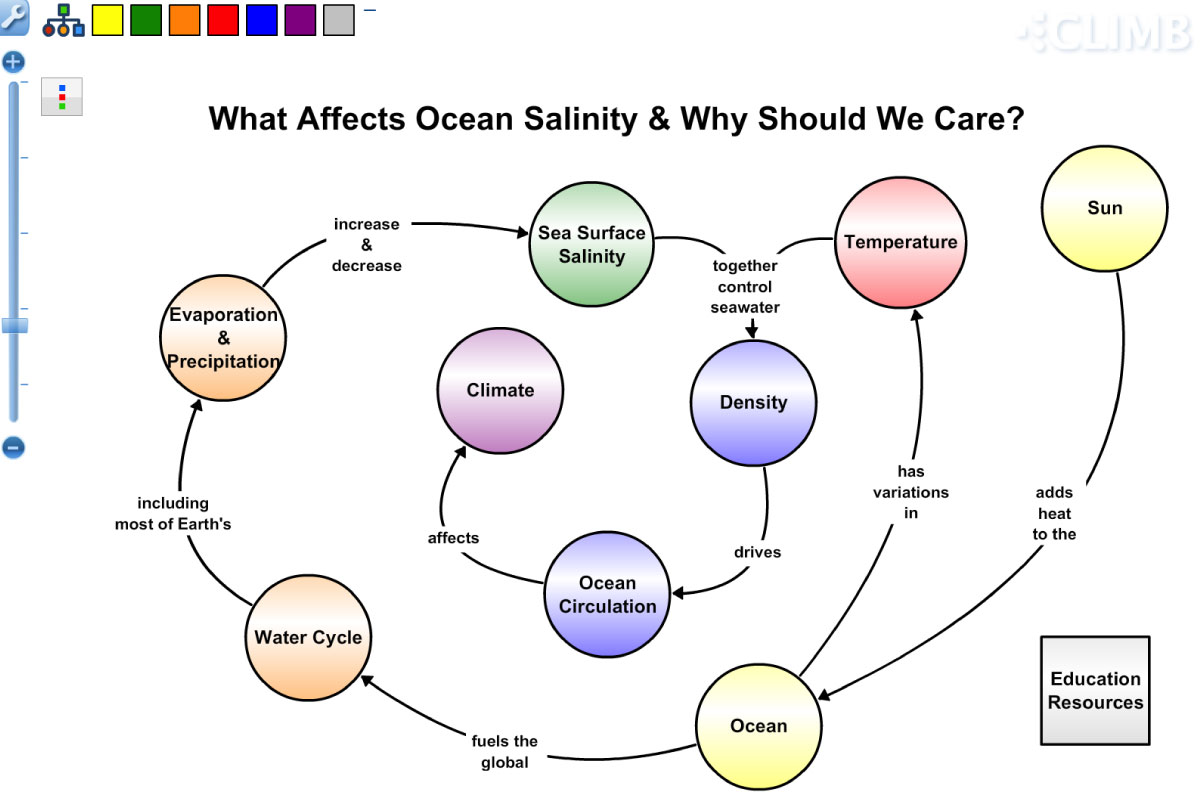What affects ocean salinity, and why should we care? The saltiness of the ocean is controlled by the water cycle. And the temperature and salinity of ocean water together control ocean density - the crucial driver of ocean circulation. Dr. Schmitt explains how ocean circulation works and its profound impacts on the climate.

Click
here for a transcript of the Q&A portion of this video (PDF, 82 KB).
Concept Map

Concept map developed for this webinar by Dr. Ray Schmitt.
Applicable Next Generation Science Standards
Disciplinary Core Idea
Variations in density due to variations in temperature and salinity drive a global pattern of interconnected ocean currents (MS-ESS2-6).
- [MS-ESS2-6] Develop and use a model to describe how unequal heating and rotation of the Earth cause patterns of atmospheric and oceanic circulation that determine regional climates.
Resources
- The Water Cycle - Now You See It, Now You Don't [NASA Aquarius]
This activity focuses on two aspects of the water cycle: evaporation and condensation
- Go With the Flow [NASA]
In this game, you "Go with the Flow" only after you have fixed the currents to take you where you want to go
- Our Mission to Planet Earth [NASA]
A guide to teaching earth system science
- Liquid Rainbow [NASA Aquarius]
When solutions of two different densities meet, the lower density solution will move on top of the higher density solution, resulting in a layering or stratification of the solutions
- Evaporation Investigation [NASA Aquarius]
The ocean is an integral part of the water cycle and is connected to all of the earth's water reservoirs via evaporation and precipitation
- Graphing Oceanographic Data [Cal-Echoes/Scripps Classroom Connection]
Students will review graphing and data interpretation using commonly collected physical oceanographic data
- Density: Sea Water Mixing & Sinking [NASA Aquarius]
Temperature and salinity help govern the density of seawater, which is a major factor controlling the ocean's vertical movements and layered circulation
- Salinity Data and Tools [NASA Aquarius]
Find the data set that most closely corresponds to sea surface salinity patterns
- Teaching Physical Concepts in Oceanography: An Inquiry Based Approach [COSEE-Ocean Systems]
This supplement to Oceanography magazine focuses on educational approaches to help engage students in learning and offers a collection of hands-on/minds-on activities for teaching physical concepts that are fundamental in oceanography
- Education: Student Outcomes [NASA Aquarius]
Twenty three student outcomes, addressed by Aquarius EPO materials and aligned with National Science Education Standards, North American Association for Environmental Education standards, and Ocean Literacy standards
- Precipitation Education [NASA]
Precipitation is a vital component of how water moves through Earth's water cycle, connecting the ocean, land, and atmosphere
- NASA Earth Observatory [NASA]
Images, maps, features, news, and notes from NASA Earth Observatory
- With a Grain of Salt [Physics Today]
Ocean surface layer captures influence of human activity
- Oceans in the News: The Water Cycle [COSEE-Ocean Systems]
A compilation of current news relevant to the water cycle
- Oceans in the News: Ocean Salinity [COSEE-Ocean Systems]
A compilation of current news relevant to ocean salinity
About the Presenter
Salinity's Connection to Climate Change and an Accelerated Water Cycle
Presented by Dr. Raymond Schmitt – March 5, 2013
SPURS Chief Scientist
Dr. Raymond Schmitt is a Senior Scientist at Woods Hole Oceanographic Institution.
Dr. Schmitt earned his Ph.D. in physical oceanography from the University of Rhode Island and his B.S. in physics from Carnegie Mellon University.
His research interests include oceanic mixing processes such as "salt fingers" and the oceanic freshwater cycle.
He has been a J.S. Guggenheim fellow and is a Fellow of the American Geophysical Union.
Read more about Ray
here.


